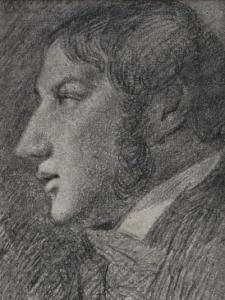(East Bergholt, Suffolk, 1776 - London 1837)
John Constable was a British painter. He grew up in a rural environment because his father was the owner of Dedham Mill and Flatford Mill. His father was a rich miller and he was an important member in his community. Although John Constable attended to some classes during that period, he was autodidact. From 1795 onwards, he travelled with frequency to London, where he was working as a topographical painter. In 1799, he entered the Royal Academy School, and in 1802, he exhibited paintings in the Royal Academy.
In 1802, he refused to work as a drawing lecturer in the Great Marlow Military College. Constable decided he wanted to become a professional landscape painter. He always had watercolours, chalk and a pencil to realize his drawings of paths, cabins and bridges that were close to his surroundings.
Constable was advised and encouraged by Benjamin West, whose influence is evident in the Altarpiece of the Brathem church (1804). Nevertheless, Gainsborough, the Dutch masters and Girtin were the ones who influenced the most in this great landscaper’s artworks, whose mark would be very strong in the Fontainebleau and the Barbizon painters and in the Romantic movement in general. His work The Hay Wain (1821, The National Gallery of London) made decisive his triumph in the Paris Salon.
Constable was one of the first in painting landscapes outdoors. In 1810 he painted his first one. In 1819 he went to Venice and Rome, where he learnt about the classicist landscapes by Claude Lorrain and by Nicolas Poussin. He also frequented Hampstead, where between 1821 and 1822 he realized several studies and researches of the clouds. In these studies he made notes of the exact hour and date of the realization, and even sometimes of the weather.
He was an incomparable master of the green colours and of the reflection of the rain over the trees, and at the same time, Constable was a meticulous realist and an impassioned Romantic. When these tendencies were in equilibrium, his masterpieces appeared: Salisbury Cathedral from the Bishop's Grounds (1823, Victoria and Albert Museum, London), The Cornfield (1826, The National Gallery, London) and Hadleigh Castle (1829). No one else has been able to grasp the damp aspect of the English countryside and its grey sky as he did it.


